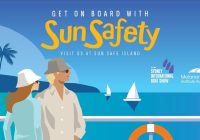Flood advice and high flows on the River Murray
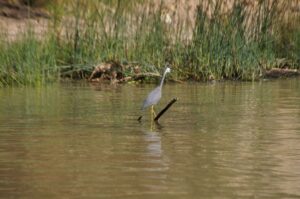
Local communities and visitors have seen river levels rise on the River Murray recently as the flows from interstate are impacted by rainfall events. The State Emergency Service issued flood advice on the 26th of August that predicted water levels are likely to cause minor flooding in the shack areas between Cadell and Mannum. Shack areas likely to be affected include (but not limited to) Morgan, Brenda Park, Scotts Creek, Walker Flat and Bowhill. Flows into South Australia are likely to exceed 60 GL/Day in two to three weeks time and are expected to remain high for several weeks.
What you should do:
- Follow your Emergency Plan now.
- Prepare your family and home for flooding in the area
- Move items of value to a safe place.
- If it is safe to do so, you should ensure drains and gutters are clear.
- For SES assistance please phone 132 500. If the matter is life threatening call 000 (triple zero)
- Regularly monitor river levels in your local area to avoid becoming isolated by flood waters.
- Camp on higher ground away from the river bank.
River Murray Flows Reports and mapping can be found on the WaterConnect website.
All Murray River users please remember to exercise caution if using the River Murray with the flood advice and high flows generally resulting in challenging conditions.:
Impacts in your area:
- Be aware that floodwaters may rise rapidly and are likely to be fast moving.
- Never allow children to play in or near floodwater.
- You should never walk, ride or drive through floodwater.
CHECK for flood warnings and local weather conditions before planning water activities.
INSPECT all safety equipment on boats before taking to the water.
HIGH FLOWS and debris can create risks for people in or on the water, be mindful that with rising water levels items may become submerged under the water creating a hazard to water users.
ALWAYS wear a lifejacket on the river.
PLAN to undertake water activities with a ‘buddy’ or in groups when possible.
Stay informed:
- Check the SES website at www.ses.sa.gov.au
- Monitor local conditions and tune to your local ABC on a battery powered radio
- Call the SA Emergency Infoline on 1800 362 361
- People who are deaf, or who have a hearing or speech impairment, can contact the SA Emergency Infoline via the National Relay Service on 1800 555 727 (TTY users 1800 555 677)
- Follow the SES on Twitter (@SA_SES) or Facebook (SA State Emergency Service)
- For weather warnings and forecasts visit BOM
SA Boating Safety Survey closed
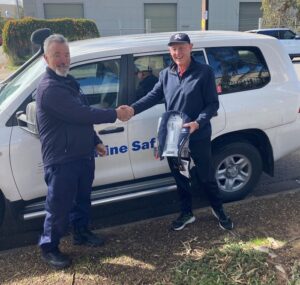
Congratulations to David, one of the lucky lifejacket winners receiving his new lifejacket from Marine Safety Officer Dave (as pictured above)
Thank you to the 663 people who filled in the SA Boating Safety Survey 2022.
The results have given the Marine Safety SA team a great insight into what recreational boaters think is important around safety and where they are getting their boating safety information. The Marine Safety SA team will use these results to help target marketing, education and compliance activities and look to improve how they deliver boating safety information to the community.
Congratulations to David (pictured above) and Wayne who from the eligible survey completions have won the two lifejackets.
Crossing safely near River Murray ferries
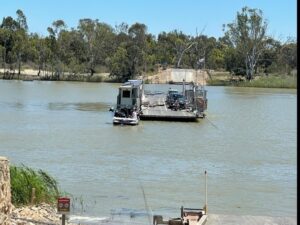
This boater crossed too close to the ferry and got caught on the ferry cable
There is the potential to strike ferry cables when operating on the River Murray due to speeding, not crossing at the mid-point of the river and crossing too close to a ferry.
The operator in the small boat pictured above crossed too close to a ferry and got caught on the ferry cables.
Remember to follow these rules to cross safely at River Murray ferry crossings:
- Within 100 metres of a ferry crossing you must reduce your speed to 4-knots either side of the crossing.
- All vessels must give way to a ferry crossing the channel and avoid crossing ahead of the ferry.
- Never pass close to a ferry that is crossing the river. The heavy steel cables used to guide the ferry may be close to the surface and can seriously damage a boat.
- Always slow down and, if necessary, stop and wait for the ferry to reach the bank before crossing. This is particularly important for those operating larger boats including houseboats.
- If your vessel is fitted with a horn, a four to six-second blast should be sounded when between 800m and 400m from the ferry, then proceed with caution.
- If your vessel is not fitted with a horn then approach the ferry with caution.
- A ferry signals its intention by showing a flashing green light when at rest on either side of the river.
- At Mannum where there are two ferries, proceed when either one or both are showing their green flashing lights.
Check your flares aren’t expired
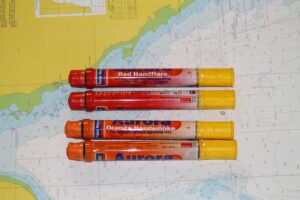
Flares have an expiry date (generally three years). If you are getting prepared for the upcoming boating season or heading out on your boat, make sure you check your flares haven’t expired.
Boating with expired flares is one of the most common issues that our Marine Safety Officers come across when checking vessels for safety equipment.
Having flares on your boat is a requirement of operating in all waters (except for protected waters such as the River Murray).
Flares must be safely disposed of by contacting your local police station to check if they will accept them for safe disposal. Visit the Marine Safety SA website to check your safety equipment requirements when boating.
Spring boat maintenance
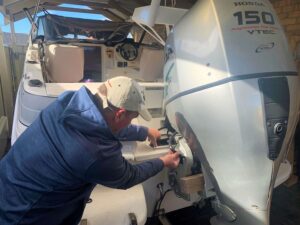
Is your boat ready to go for spring and summer. Early September is a great time to carry out important boat maintenance. Make sure your boat is seaworthy by following these key steps:
- Have a general visual inspection of your engine, hull for corrosion, cracks and general wear and tear. Make sure your boat equipment, radio and safety equipment is ready to go and that your trailer can safely carry your boat for launching.
- Thoroughly check the following:
Machinery – engine oil levels, tilt and trim, fuel and fuel filters including tanks lines and clips, bilge pump, gear box oil, coolant water intake, hydraulic steering, anodes, propeller (bolts / blades), collar air pressure (for inflatables), fuel caps / breathers on portable tanks.
Equipment – batteries / terminals and battery isolation, mooring lines, lanyard, navigation and flood lights, deck lights, compass, horn, fenders and steering system.
Marine Radio – if operating in unprotected waters you will need a VHF, MF/HF or 27 MHz (27 Meg) Marine Radio. Test it is working before going out.
Trailer – brake levers, lights, winch and cable, safety chains and links, tie down straps, tyre pressure, trailer coupling, safety lock, grease on bearings and rollers / skids.
Safety equipment – must be on board and working. Check out all your safety equipment needs for where you are boating.
Using an unseaworthy boat is an offence and the owner or skipper may be prosecuted. Make sure your boat is ready to hit the water.
Upgrades to Beachport and Southend jetties
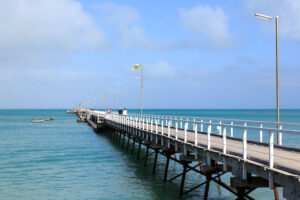
Work is being undertaken to upgrade and repair the heritage-listed Beachport and Southend jetties to ensure their long-term structural integrity for all users.
Southend Jetty will undergo repairs to four lower landings and replacement of two others that were damaged by large swells. The jetty will be temporarily closed while work is undertaken. The jetty is expected to reopen in September 2022 in time for the fishing season, with full project completion expected in early 2023.
Beachport Jetty upgrades will include the refurbishment of timber piles, framework, steel cross bracing, decking and railings, installation of new safety ladders and repairs to the landings, handrails and fenders.
To safely facilitate these works, the sea-end of the Beachport Jetty will be closed to the public, while the shore end will be closed intermittently. Work is due to start in September 2022 and expected to be completed in the third quarter of 2023.
Work will generally be undertaken from Monday to Sunday, between 7am and 5pm each day (weather permitting).
Reminder – upgrade works at Outer Harbor Boat Ramp
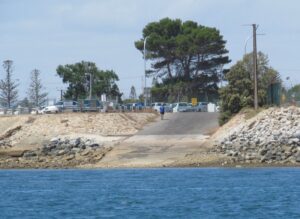
Upgrade work at the Outer Harbor Boat Ramp and Bourne Jones Road will continue until early September, weather permitting.
The work will include upgrades to the carpark and improvements to stormwater drainage, directing outflow away from the Royal South Australian Yacht Squadron.
Some restrictions are in place around the works. Please follow directions on all signage and drive carefully in the area.
Birkenhead Bridge maintenance works
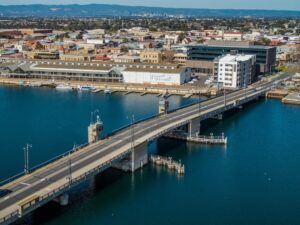
Maintenance work will be undertaken on Birkenhead Bridge, Port Adelaide from Monday 29 August to Friday 2 September 2022, 9am to 4pm each day (weather permitting).
The bridge will be unable to open for boat traffic for the duration of the works, meaning tall vessels (such as sailing boats) will not be able to pass. Mariners are advised to navigate with caution in the area.
Nelson Street will remain open during these works, with a single lane of traffic operating in one direction each day. Please follow the direction of onsite traffic controllers and drive safely.






